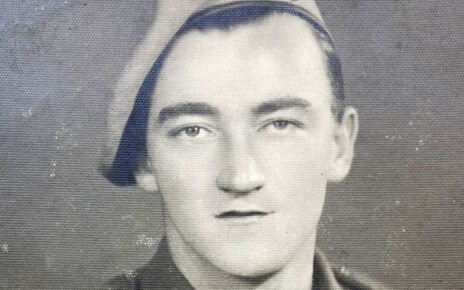Wind turbine engineer ‘Mr Safety’ whose farm was sliced off in gruesome accident on North Sea windfarm could be line for £1million payout as he WINS compensation court battle
- Darren Hoadley, 42, suffered the traumatic accident at a farm in the North Sea
A wind turbine engineer dubbed ‘Mr Safety’ who sued for over £1million after his arm was sliced off while working on a North Sea wind farm has won his compensation fight at the High Court.
Darren Hoadley, 42, a specialist wind turbine installer, was checking the bearings in the mechanism which spins the blades when the rotating machine sliced through his arm ‘like a guillotine’ and ‘traumatically amputated his left arm’ in June 2018.
The injury came as Mr Hoadley – nicknamed ‘Mr Safety’ by workmates due to his reputation for diligence on the job – worked at the Rentel offshore wind farm in a Belgian-controlled sector of the North Sea.
Mr Hoadley sued his employer, Siemens Gamesa Renewable Energy Ltd, over his gruesome accident, claiming it could have been avoided had he known that the power source which was slowly turning the turbine at the time had not been deactivated.
After a judge found the company mostly to blame at the High Court, Mr Hoadley, from Norfolk, has now won the right to a massive compensation payout, which lawyers say is likely to be more than £1million.
Darren Hoadley, 42, a specialist wind turbine installer, was checking the bearings in the mechanism which spins the blades when the rotating machine sliced through his arm ‘like a guillotine’ in 2018
After retraining to retain his specialist job, Mr Hoadley has now won a legal battle for compensation
However, the exact amount he will receive will be decided at a later date and reduced by a third after Judge Richard Davison found that Mr Hoadley was also partly at fault.
The judge ruled he ‘failed to plan’ and ‘assumed what he should not have assumed’ after the last staff to leave the site the morning of the incident turned the power on without telling colleagues or placing appropriate warning signs to notify them.
The life-changing accident occurred while the engineer was checking parts in a cramped ‘nacelle’ pod attached to the top of the turbine’s upright body and close to the hub around which the blades turned, the court heard.
He had reached his arm through a hole in the turbine brake disc to check a series of safety pins and was horrified when he realised that the turbine was rotating slowly under power and that his arm had become stuck.
Mr Hoadley described the horror of realising he was about to lose his limb, saying in evidence: ‘I could easily see the lock from a hole in the disc, so I proceeded to check the lock by placing my left arm through the hole and check the lock.
‘It was fine, but then I realised I could not move my arm. I then realised the disc was still moving slowly and I was going to lose my arm.’
Describing the accident, Judge Richard Davison said: ‘Upon completion of the check, he could not retrieve his arm and he realised that the generator was moving, and he had no way to stop it.
‘What then happened was that the stationary single blade mounting tool, immediately behind the brake disc, acted as a guillotine which traumatically amputated his left arm.’
The judge praised his ‘courage and presence of mind’ in being able to get out of the dark and cramped confines of the pod immediately after his injury.
‘The key features of the accident are that the claimant thought that the brake disc was locked and immobilised and that the power was off,’ he said.
‘He therefore thought he was safe in what he was doing, but both assumptions were incorrect.
‘He did not realise his mistake until his arm was already trapped and it was too late to do anything about it.’
Mr Hoadley competed in Run Norwich, an annual 10km running race, just seven weeks after the accident
The life-changing accident occurred while the engineer was checking parts in a cramped ‘nacelle’ pod attached to the top of the turbine’s upright body (stock image)
The judge ruled that Siemens Gamesa were at fault because other technicians working in the pod had previously turned on the power without properly alerting colleagues.
READ MORE: Look out for low bridges! Enormous 212ft turbine blade makes its slow way through the Scottish Borders on its way to wind farm
‘The technicians who were the last to leave the nacelle in the morning removed the rotor locks and reactivated the power without reinstating the chain and warning sign which were intended to and would have alerted incoming staff to the fact that the system was energised,’ he said.
‘They also left the door to the nacelle open… which contributed to the false impression that the power was isolated and which had the unfortunate side effect of obscuring vision of the control panel for the slow speed turning device.’
The accident was also contributed to by the silent mechanism of the devices in the pod, which lulled Mr Hoadley into a false sense of security, plus his own inattention on the fateful day, he added.
‘On this occasion, he failed to live up to his reputation as ‘Mr Safety’,’ the judge noted.
‘He failed to involve his installation lead. He failed to plan.
‘He was working alone when he should not have been – and having a radio with him was no answer to that when there was no one nearby to summon and no one to act as a second pair of eyes over what he was doing.
‘Lastly, he assumed what he should not have assumed without checking.’
Mr Hoadley was judged one-third to blame for his injuries, which means he will recover two thirds of whatever damages award is ultimately allocated him by the courts.
The assessment of damages will be heard at a later date, with Mr Hoadley expected to claim more than £1m for his life-changing injuries.
As well as praising Mr Hoadley for his coolness and courage in the immediate aftermath of the tragedy, the judge commended him for his resilience in ‘adapting and coping’ since the accident.
After having his arm cut off, Mr Hoadley feared that the job for which he had a special expertise was now beyond him and commented in an interview: ‘For a long time I felt as though part of my identity was missing.
‘This haunted me for a while and I struggled with the uncertainty that flooded my future.’
But after fitting a prosthetic arm and intensive on-the-job support, he was able to get back to work, undergoing a series of gruelling safety and competence tests, including sea survival, helicopter rescue and working at heights.
During his sea survival training, Mr Hoadley had to get back up a ladder for the first time in four years and technicians had to adapt the hook on his artificial limb to help him cope.
He also competed in Run Norwich, an annual 10km running race, just seven weeks after the accident – completing the event in just 1 minute 30 seconds longer than the previous year.
His wife Sue Hoadley said at the time: ‘We have Run Norwich together nearly every year, and he wanted to run again this year, despite the difficult circumstances.
‘Darren is determined to not let what life has thrown at him stop him from achieving – and he was only 1 minute 30 seconds slower than last year!
‘He makes me incredibly proud everyday, and he is an amazing role model for our girls.’
At the end of his ruling, the judge also commended Siemens Gamesa for their post-accident reaction and for ushering in ‘immediate and effective reforms to their equipment and procedures.’
Source: Read Full Article






